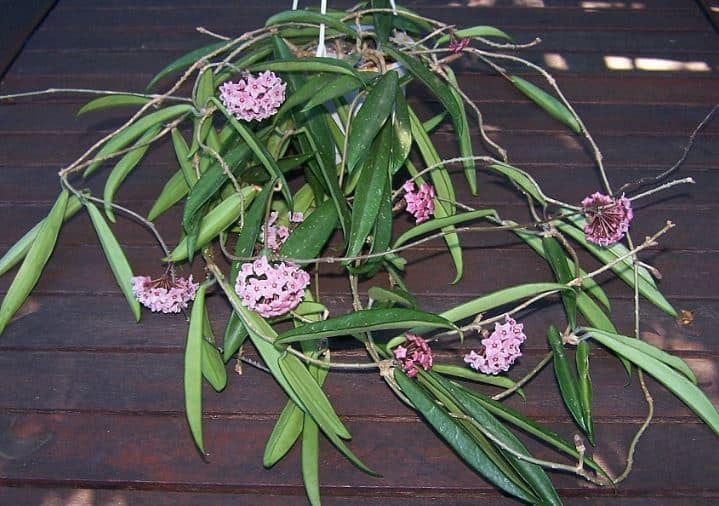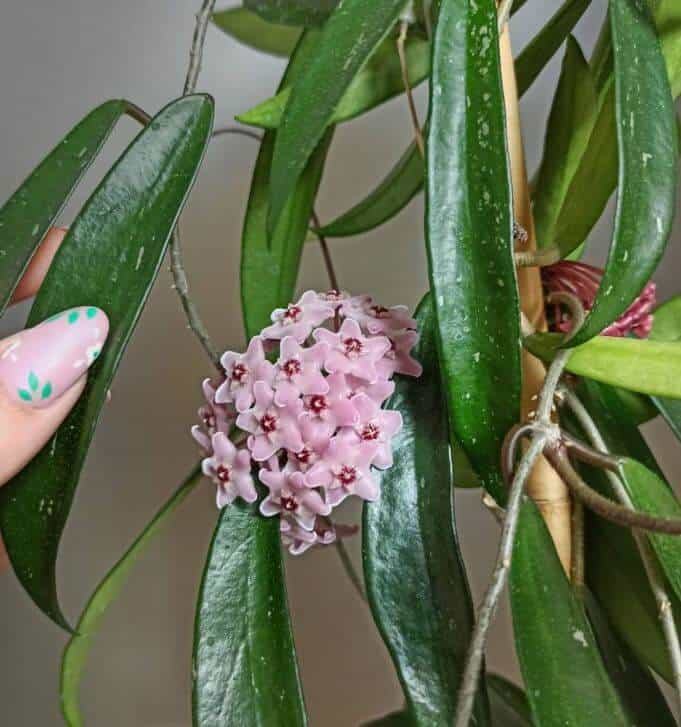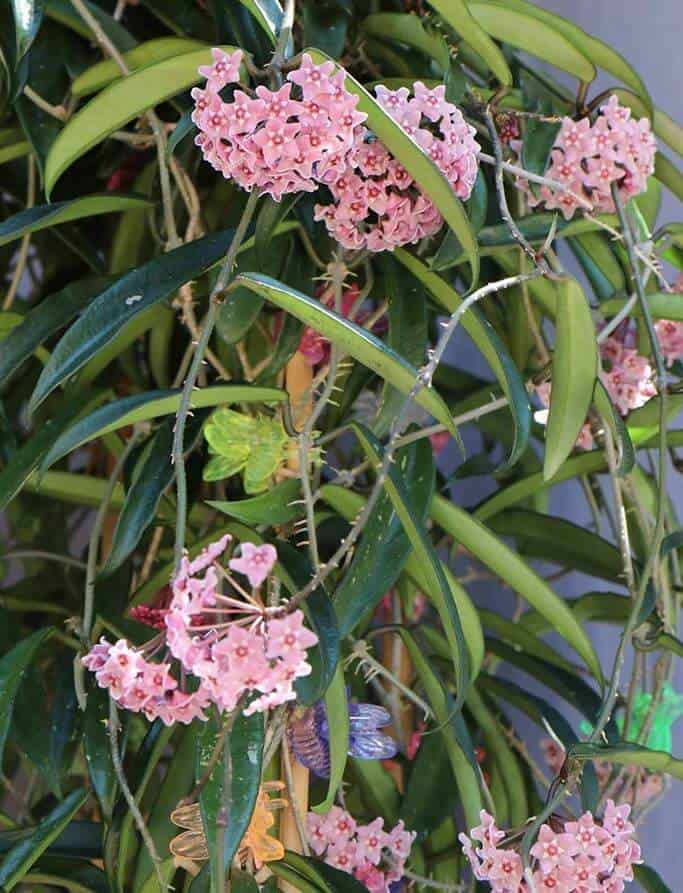Last Updated on May 2, 2023 by a Friendly Gardener
The Hoya ‘Minibelle’ is a delightful hybrid that is a cross between a Hoya carnosa and a Hoya shepherdii. This evergreen climbing plant features waxy fragrant flowers, and attractive leaves, and takes its name from the wife of the hybridizer, Minibelle Hummel.
Members of the Apocynaceae family, the Hoya Minibelle Splash produces multiple star-shaped pink flowers with purple centers are produced in an umbel shape beginning in late spring through the summer. Blooms are produced from spurs and have a fuzzy appearance thanks to tiny hairs. They may drip excess nectar when produced. Because new flowers will emerge from the same spurs, these should never be removed.
Hoya Minibelle Splash leaves are elongated, stiff, and succulent-like with silver variegations and speckles on a green background. This plant produces an impressive fragrance that is most evident in the early evening.
Hoya Minibelle Plant Care

Known as the Wax plant, Wax vine, or Porcelain Flower plant, due to its thick, waxy-like foliage, the Minbelle Splash cultivar distinguishes itself for its elongated foliage.
Soil
Soil needs to be very well-draining for this plant to thrive as waterlogged soil will cause the plant to fail beginning with yellowing leaves, root rot, and death. Blend one-third potting mix with one-third perlite, one-sixth orchid bark, and one-sixth sand. This will create a growing medium that is light and well-aerated. Hoyas are epiphytic plants in their natural habitats so they will appreciate a bit of orchid bark to cling to. If you don’t have the time to blend the soil mix, purchase a succulent soil formula and add a little perlite. Soil pH should be neutral to acidic measuring in the 6.1 to 7.5 range.
Repotting

Although these plants don’t mind being slightly root-bound, these plants should be repotted at least once every other year. Repot in the springtime two to three days after watering. Select a planter with adequate drainage holes. Clay or terracotta pots are great options as they help wick away excess moisture.
Light

Bright, indirect light is ideal for the Hoya Minibelle. This plant can tolerate a little bit of direct light in the early morning or early evening. It should not be exposed to harsh, direct sunlight during the day, as this will scorch the foliage which will be yellow.
Water
The Hoya Minibelle should be watered deeply, but excess water should be allowed to drain completely. Overwatering and soggy soil will lead to yellowing foliage and root rot.
Humidity
As tropical epiphytes, the Hoya Minibelle enjoys humidity. A pebble tray or space humidifier will contribute significantly to keeping your Minibelle’s humidity levels at a good level.
Temperature
Hoya Minibelles are not frost tolerant. It can manage environmental temperatures as low as 60°F. They will not survive temperatures that remain at 95°F. or above. When cultivated indoors, try to provide a temperature in the 65° to 80° F. range.
Feeding
Feed your Hoya hybrid often during the growing season. Use a balanced organic liquid fertilizer that has been significantly diluted and apply it every other watering. Do not allow your plant’s soil bed to dry out completely. Opt for an organic fertilizer to prevent salt buildup in the soil bed as buildup risks causing root burning and Hoya root systems are delicate and sensitive.
Pruning

Dead or damaged vines should be removed. Try to avoid pruning your Hoya during flowering. Hoya plants produce peduncles on stem tips from which flowers emerge. These spurs produce blooms for the entire life of the plant so they should never be removed. Avoid cutting long tendrils that will eventually develop foliage.
Hoya Minibelle Propagation

Hoya plants are usually propagated using stem cuttings. These stem cuttings can be placed in water, sphagnum moss, or potting soil for root development. Trim a stem cutting with a minimum of two leaf nodes. Remove the foliage on the cutting’s bottom half. Vine tips should remain untouched. Dip the cut end into the rooting hormone to better your chances of successful propagation. Put the cut end into moss or potting soil and water deeply permitting excess moisture to drain out.
The growing medium should remain moist as you wait for root development. Stem cuttings can also be inserted into a glass jar with water. Foliage should remain above the water’s surface. Change the water at least weekly. When roots develop, your cutting can be transplanted into soil.
Hoya Minibelle Problems
Leaf drop, especially on a plant producing new foliage indicates a watering problem. Oversoaking a plant or leaving too much time between waterings can cause leaf drop of foliage not fully matured.
Yellowing foliage is a result of overwatering. Check to see if your plant is draining excess water correctly. Allow the soil bed surface to dry out somewhat before you water anew.
Thin leaves also indicate water stress. Check for adequate drainage or soil that has compacted. Wrinkled foliage may indicate your plant is thirsty or it may indicate that roots are rotting. Remove your plant from its container and examine the root system. Misshapen or stunted leaves can be caused by water or environmental temperature stress.
A lack of growth or very slow growth can result from an environmental change. Any change can send your plant into dormancy causing growth to stop for weeks or months. If you have recently moved this plant, be patient and allow it time to adapt.
Hoya Minibelle plants are susceptible to pest infestations from thrips, scale insects, spider mites, and mealybugs. Pests should be removed with a water jet spray and then your Hoya plant can be treated with insecticidal soap spray or horticultural neem oil.
Occasionally, your plant may be reticent to bloom. Fortunately, many hoya cultivars have adapted to drought-like conditions. Withholding water from your Hoya Minibelle Splash for a couple of weeks in the spring can aid in encouraging flowering.
Hoya Minibelle Toxicity
Hoya plants are not known to be toxic to humans or animals, although the plant’s sap can be irritating to the skin.


